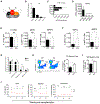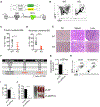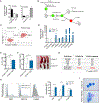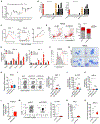The Hematopoietic Oxidase NOX2 Regulates Self-Renewal of Leukemic Stem Cells
- PMID: 30943405
- PMCID: PMC6931909
- DOI: 10.1016/j.celrep.2019.03.009
The Hematopoietic Oxidase NOX2 Regulates Self-Renewal of Leukemic Stem Cells
Abstract
The NADPH-dependent oxidase NOX2 is an important effector of immune cell function, and its activity has been linked to oncogenic signaling. Here, we describe a role for NOX2 in leukemia-initiating stem cell populations (LSCs). In a murine model of leukemia, suppression of NOX2 impaired core metabolism, attenuated disease development, and depleted functionally defined LSCs. Transcriptional analysis of purified LSCs revealed that deficiency of NOX2 collapses the self-renewal program and activates inflammatory and myeloid-differentiation-associated programs. Downstream of NOX2, we identified the forkhead transcription factor FOXC1 as a mediator of the phenotype. Notably, suppression of NOX2 or FOXC1 led to marked differentiation of leukemic blasts. In xenotransplantation models of primary human myeloid leukemia, suppression of either NOX2 or FOXC1 significantly attenuated disease development. Collectively, these findings position NOX2 as a critical regulator of malignant hematopoiesis and highlight the clinical potential of inhibiting NOX2 as a means to target LSCs.
Keywords: CEBPε; FOXC1; NF-κB; NOX2; ROS; acute myeloid leukemia; differentiation; fatty acid oxidation; glycolysis; leukemia stem cells; p22Phox; self-renewal.
Copyright © 2019 The Authors. Published by Elsevier Inc. All rights reserved.
Conflict of interest statement
DECLARATION OF INTERESTS
The authors declare no competing interests.
Figures







References
-
- Baillet A, Hograindleur MA, El Benna J, Grichine A, Berthier S, Morel F, and Paclet MH (2017). Unexpected function of the phagocyte NADPH oxidase in supporting hyperglycolysis in stimulated neutrophils: key role of 6-phosphofructo-2-kinase. FASEB J. 31, 663–673. - PubMed
-
- Cabezas-Wallscheid N, Klimmeck D, Hansson J, Lipka DB, Reyes A, Wang Q, Weichenhan D, Lier A, von Paleske L, Renders S, et al. (2014). Identification of regulatory networks in HSCs and their immediate progeny via integrated proteome, transcriptome, and DNA methylome analysis. Cell Stem Cell 15, 507–522. - PubMed
-
- Cancelas JA, Lee AW, Prabhakar R, Stringer KF, Zheng Y, and Williams DA (2005). Rac GTPases differentially integrate signals regulating hematopoietic stem cell localization. Nat. Med 11, 886–891. - PubMed
Publication types
MeSH terms
Substances
Grants and funding
LinkOut - more resources
Full Text Sources
Other Literature Sources
Medical
Molecular Biology Databases
Research Materials
Miscellaneous

